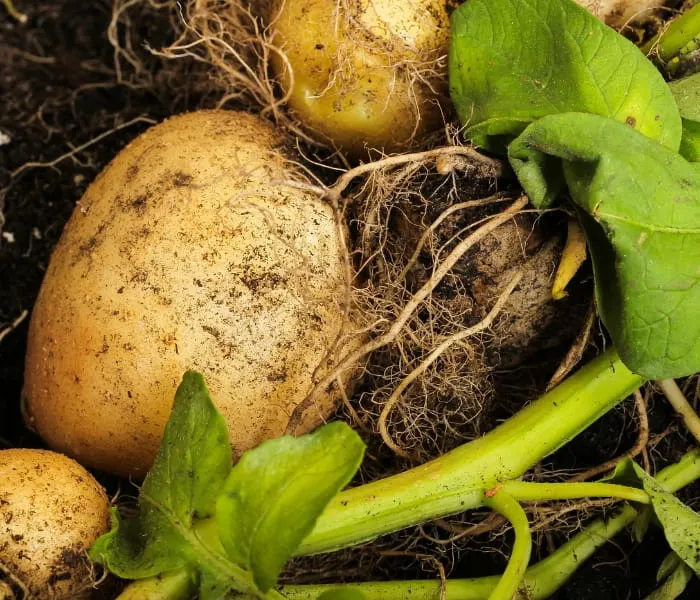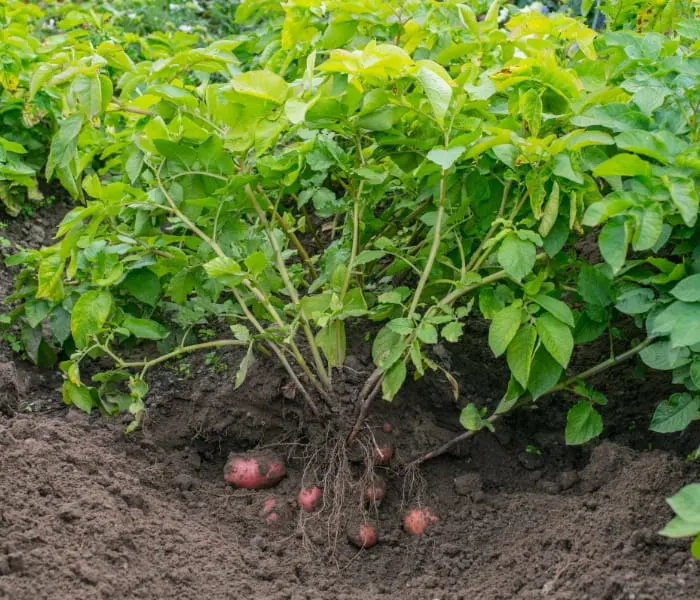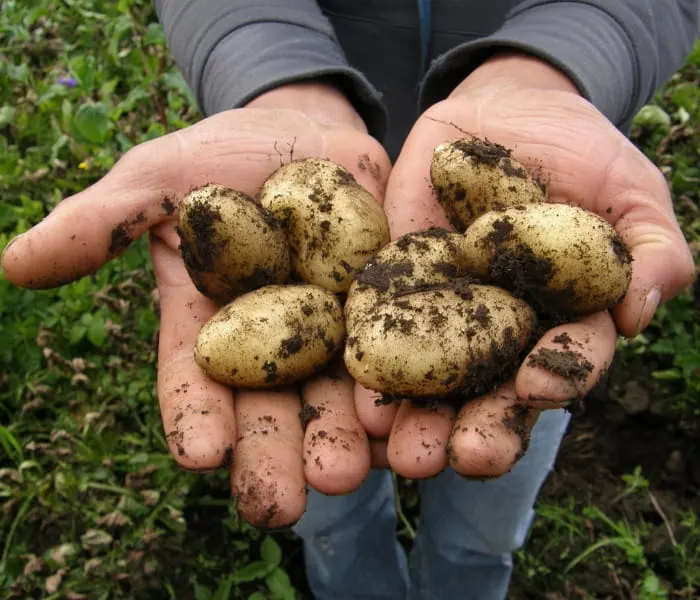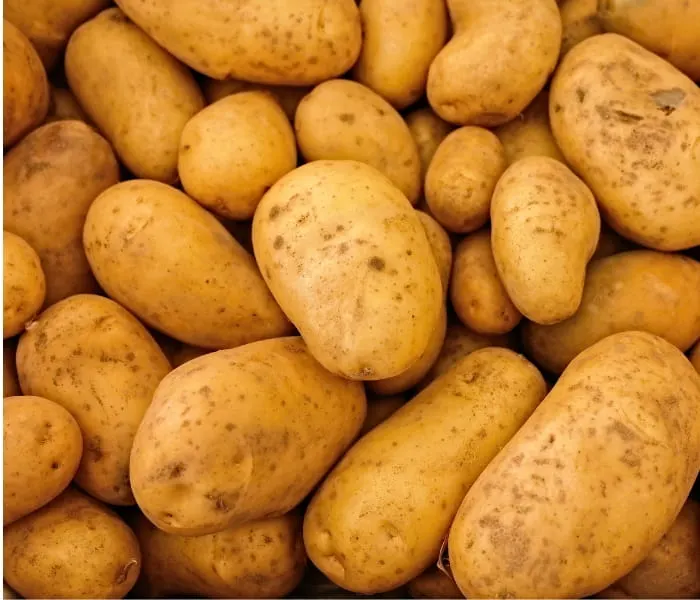Greetings, fellow potato enthusiasts! Are you ready to embark on a spud-tacular adventure? Growing your own potatoes can be a rewarding experience that not only fills your pantry with delicious tubers but also brings you closer to nature.
Whether you’re a seasoned gardener or just starting your green-thumb journey, this article is here to provide you with 20 fantastic tricks to help you cultivate an abundant potato harvest.
1. Select the Right Varieties:

Choosing the right potato variety is crucial for a successful harvest. Consider factors like the climate in your region, the desired taste, and the intended use of the potatoes (e.g., baking, boiling, or frying). Popular varieties such as Yukon Gold, Russet, and Red Pontiac are reliable options for most gardeners.
2. Prep the Soil:
Prepare a nutrient-rich bed for your potatoes by adding organic matter, such as compost or well-rotted manure. Loosen the soil to a depth of at least 12 inches to ensure good drainage and aeration.
3. Chit Your Potatoes:
Before planting, “chitting” your potatoes can give them a head start. Place them in an egg carton or tray, ensuring the “eyes” are facing upward. Leave them in a cool, bright location for a few weeks until sprouts emerge.
4. Planting Techniques:
When it’s time to plant, dig trenches about 4-6 inches deep and space them about 12-15 inches apart. Place the chitted potatoes in the trenches, ensuring the sprouts face upwards. Cover them with soil and water gently.
5. Hilling:
As your potato plants grow, mound soil around the stems to encourage additional tuber development. This hilling technique also helps prevent sunlight from reaching the tubers, preventing them from turning green.
6. Mulching Magic:

Applying a layer of organic mulch, such as straw or shredded leaves, around your potato plants helps retain moisture, suppress weeds, and regulate soil temperature.
7. Watering Wisely:
Potatoes need consistent moisture, especially during tuber formation. Water them deeply once or twice a week, ensuring the soil remains evenly moist but not waterlogged. Remember, potatoes don’t like wet feet!
8. Fertilizing Finesse:
Feed your potato plants with a balanced organic fertilizer during planting and throughout the growing season. Avoid excessive nitrogen, as it promotes excessive foliage growth at the expense of tuber production.
9. Combat Common Pests:
Keep pesky pests like Colorado potato beetles at bay by inspecting your plants regularly and removing any eggs or larvae you spot. Introduce beneficial insects like ladybugs to help control aphids and other harmful insects.
10. Defend Against Diseases:
Prevent diseases like late blight by practicing crop rotation and avoiding planting potatoes in the same spot for consecutive years. Choose disease-resistant potato varieties when possible.
11. Companion Planting:
Planting potatoes alongside compatible companions can enhance growth and deter pests. Try pairing them with marigolds to repel nematodes or with beans to fix nitrogen in the soil.
12. Pruning the Foliage:
When your potato plants reach about 6-8 inches in height, consider pruning off the lower leaves. This redirects the plant’s energy towards tuber production and improves air circulation.
13. Monitor Sun Exposure:

While potatoes require full sun for optimal growth, excessive heat and direct sunlight can scorch the foliage. Monitor their sun exposure and consider providing partial shade during intense summer months.
14. Timely Harvesting:
Harvesting potatoes at the right time ensures maximum flavor and yield. Wait until the foliage turns yellow and dies back, then carefully dig up the tubers. Avoid leaving them exposed to sunlight for long to prevent greening.
15. Cure and Store Properly:
After harvesting, cure your potatoes by storing them in a cool, dark, and well-ventilated area for a couple of weeks. This helps toughen the skin and extend their storage life.
16. Try Containers:
Short on garden space? Grow potatoes in containers like large pots, bags, or even old tires. Fill them with a good-quality potting mix and follow the same planting and care techniques as for in-ground cultivation.
17. Experiment with Varieties:
Don’t be afraid to try new and unusual potato varieties. Purple Peruvian, Fingerling, or Blue Congo potatoes can add color and excitement to your harvest, making your meals even more visually appealing.
18. Extend the Harvest:

To enjoy a continuous potato harvest, stagger your planting. Plant early, mid, and late-season varieties at different times to stretch your harvest throughout the season.
19. Save Seed Potatoes:
Rather than purchasing seed potatoes every year, save a portion of your harvest as seed for the next season. Select the best-quality potatoes and store them in a cool, dark place until planting time.
20. Celebrate and Share:
Finally, celebrate your successful potato harvest with a feast! Invite friends and family to enjoy the fruits (or rather, tubers) of your labor. Share your surplus potatoes with neighbors or local food banks, spreading the joy of homegrown produce.
Common Potato Plant Growing Problems and Solutions
While growing potatoes can be a rewarding endeavor, like any gardening pursuit, it comes with its fair share of challenges. Don’t fret! In this section, we will explore some common problems you may encounter while growing potato plants and provide practical solutions to overcome them.
Pest Infestations:
Problem: Potatoes are susceptible to various pests, including Colorado potato beetles, aphids, and wireworms. These invaders can cause significant damage to foliage and tubers, leading to reduced yields.
Solution: Regularly inspect your plants for signs of pests. Remove any pests or eggs you find manually. Introduce beneficial insects like ladybugs and lacewings to control aphids naturally. Consider using organic insecticides or insecticidal soaps for severe infestations.
Fungal Diseases:
Problem: Potato plants are prone to fungal diseases such as late blight, early blight, and powdery mildew. These diseases can cause wilting, leaf spots, and rotting of tubers.
Solution: Practice good crop rotation by avoiding planting potatoes in the same spot for consecutive years. Choose disease-resistant potato varieties whenever possible. Apply copper-based fungicides early in the growing season as a preventative measure. Remove and destroy any infected plants to prevent the spread of diseases.
Soil-borne Diseases:
Problem: Soil-borne diseases like common scab and bacterial wilt can affect potato plants. These diseases can cause scaly or rough patches on tubers and wilting of foliage.
Solution: Improve soil drainage by adding organic matter and avoiding overwatering. Ensure proper crop rotation to reduce the risk of soil-borne diseases. Use disease-free seed potatoes and avoid planting infected tubers. Consider using biocontrol agents or soil amendments specifically designed to suppress soil-borne diseases.
Nutrient Deficiencies:
Problem: Insufficient or imbalanced nutrient levels in the soil can lead to nutrient deficiencies in potato plants. Common deficiencies include nitrogen, phosphorus, and potassium.
Solution: Test your soil before planting to determine nutrient deficiencies. Amend the soil with organic fertilizers or specific nutrient supplements to address deficiencies. Follow recommended fertilization schedules throughout the growing season. Regularly monitor the appearance of leaves for signs of nutrient deficiencies and adjust fertilizer applications accordingly.
Excessive Foliage Growth:
Problem: While lush foliage is desirable, excessive foliage growth can divert energy away from tuber production, resulting in smaller yields.
Solution: Practice proper pruning by removing the lower leaves once the plants reach a certain height. This encourages energy allocation towards tuber development. Additionally, ensure plants receive adequate sunlight and nutrients for balanced growth.
Overwatering or Underwatering:
Problem: Incorrect watering practices can cause problems for potato plants. Overwatering can lead to root rot and fungal diseases, while underwatering can result in stunted growth and reduced tuber development.
Solution: Water potato plants deeply once or twice a week, ensuring the soil remains evenly moist but not waterlogged. Use your finger or a moisture meter to determine soil moisture levels. Mulching around plants helps retain moisture and regulate soil temperature.
Environmental Factors:
Problem: Extreme weather conditions, such as heatwaves or frost, can negatively impact potato plants. Heat stress can cause wilting, while frost can damage foliage and tubers.
Solution: Provide shade or temporary covers during intense heatwaves to protect plants from excessive heat. Cover young plants with frost blankets or straw during cold nights to prevent frost damage. Monitor weather forecasts and take preventive measures accordingly.
Congratulations, fellow potato enthusiasts, you’re now armed with 20 incredible tricks to grow tons of potatoes! Remember, gardening is an adventure, and even if you encounter a few bumps along the way, enjoy the process and relish in the delicious rewards of your hard work.
So, grab your gardening tools, don your favorite potato-themed apron, and get ready to dig into a bountiful potato harvest like never before. Happy gardening and happy potato feasting!
